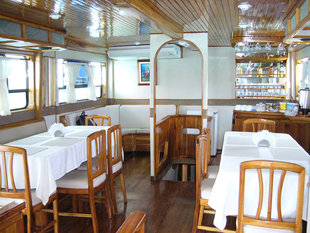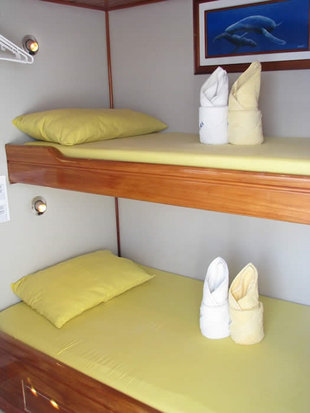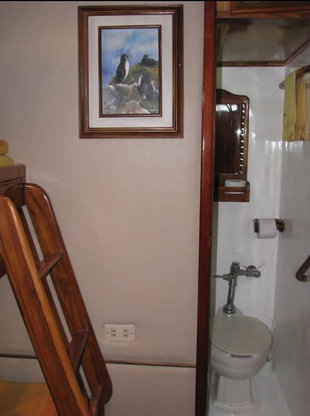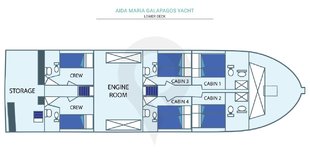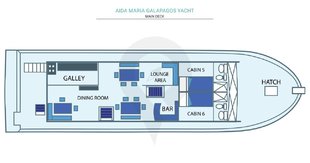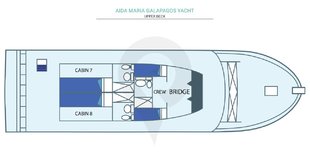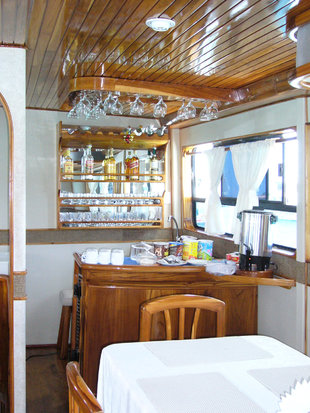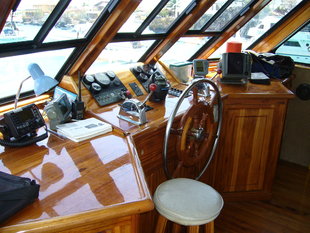Aida Maria was built in Ecuador and is custom made for Galapagos islands wildlife holiday cruising. She has been cruising around the Galapagos Islands since 1997 and offers a comfortable and leisurely vacation cruising experience.
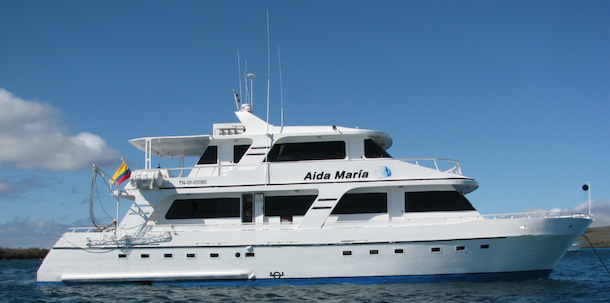
The Aida Maria motor yacht can accommodate up to sixteen passengers within her 8 double cabins, all of which are equipped with private en-suite facilities, air conditioning and access to external deck.
Aida Maria has a spacious sun deck, providing the perfect spot to observe the dramatic scenery of the Galapagos, seabirds and watch for marine life to surface. There is an interior buffet and dining area which serves up delicious local specialities and international cuisine. There is an additional social area comprising a well equipped bar, TV and DVD player, stereo and library.
Aida Maria is a great choice for those interested in exploring the islands and waters of the Galapagos making use of her onboard snorkel gear.
Technical Specifications
|
|
|
|
|
|
|
|
|
|
|
|
|
|
|
|
|
|
|
|
|
|
|
|
|
|
|
|
|
|
|
|
|
|
|
|
Itinerary
Aida Maria
For the Aida Maria we are showing the full 15 days itinerary and how you can board for different parts of it.
Itinerary A = days 1 - 8
Itinerary B = days 8 - 15
Itinerary C = days 1 - 5
Itinerary D = days 5 - 8
Itinerary E = days 5 - 10
Itinerary F = days 10 - 15
Please note that these itineraries are subject to change without notice due to seasonal changes, last minute weather conditions and the decision of the Galapagos National Park authority.
Day 1: Baltra Island, Las Bachas Beach (wet landing)
Itinerary A is the first 8 days / 7 nights starting Baltra & ending Baltra
Itinerary C is the first 5 days / 4 nights starting Baltra & ending San Cristobal
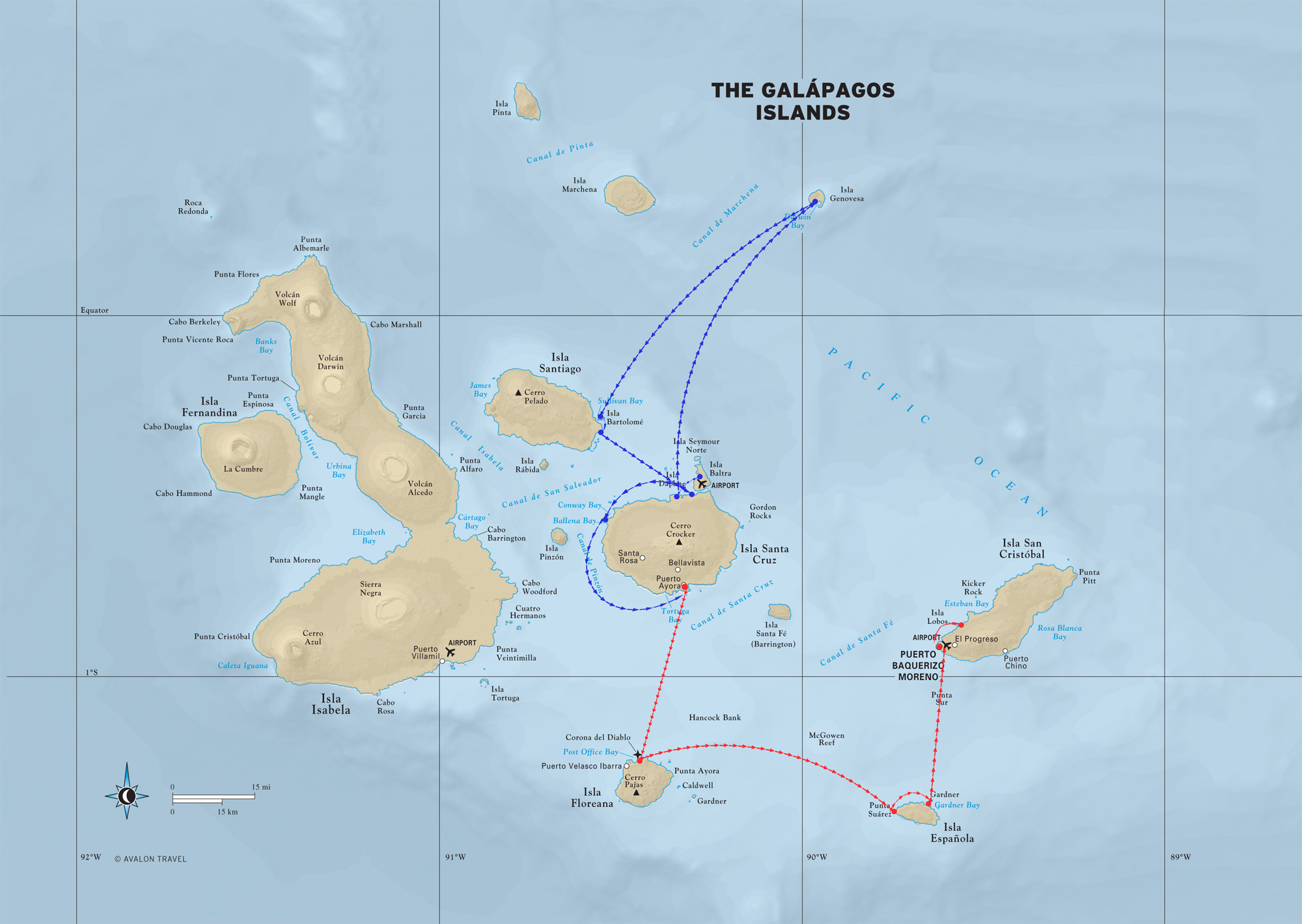
Itinerary C in Blue. Itinerary D in Red. Itinerary A = Blue + Red.
When you arrive at Baltra airport, you will need to pay your Galapagos National Park fee and collect your luggage. As you step out of the Arrivals Hall, your bilingual naturalist guide will be there too greet you. During lunch he/she will introduce you to the islands, specifically the flora and fauna that you will encounter at our first destination, Las Bachas Beach. On the sandy white beaches of Las Bachas you will get a close look at a sea turtle nesting area as well as a lake frequented by pink flamingos and other migratory birds. Marine iguanas sometimes swim across this lake; and can certainly be found warming themselves of sand and rocks between lake and beach. The rockpools are a great place to observe Sally Lightfoot Crabs - a great location to photograph them.
Afterwards, you will have the opportunity to cool off with a dip in the beautiful, blue Pacific Ocean. As this is the first evening together, the crew will invite everyone to a pre-dinner cocktail on the yacht before the welcome dinner. If the night is clear, as it usually is, the stars above will sparkle; look for the Southern Cross, the Big Dipper (turned up-side down!) and Orion's Belt.
Dat 2: Genovesa Island: Darwin Bay (wet landing) / El Barranco (dry landing)
Early in the morning you'll have breakfast and then you'll disembark at Genovesa "Tower" Island, which is located in the northeastern part of the Galapagos (less than half a degree north of the Equator).
At Tower Island you'll anchor at Darwin Bay, which is located on the southern part of the island, and is actually the caldera of an extinct, partially eroded volcano, with the surrounding cliffs forming the inner lining of the rim. While the origin of the name Tower is not known, one can imagine it had something to do with these towering cliffs. The tour will be a long, fairly-easy walk, but it is usually hot and dry here, so you may want to carry some water. After a wet landing on a coral beach the trail begins in an area where there are several swallow-tailed gulls. As you walk back from the beach, you'll see a variety of Opuntia cactus and mangroves.
Tower is an outpost for many sea birds (as is Española is in the south). It has the largest population by far of Red-Footed Boobies - attracted to this location because there are no Galapagos Hawks to prey on them. Interestingly, there are almost no land reptiles on Tower; only very small marine iguanas. This is attributed to the direction of the ocean currents, which wouldn't have carried the terrestrial animals here.
Visit El Barranco during the afternoon then return to the boat for dinner.
Day 3: Bartolome / Sullivan Bay
Bartolome Island, which at its highest point is 114 meters, is one of the most photographed vistas in the archipelago. This island is quite young and volcanic, therefore, it's relatively unpopulated; only a small handful of die-hard plant and animal species have survived long enough to call this lava-land home.
After the visit to Bartolome Island you'll visit nearby Sullivan Bay. At the turn of the century a huge lava flow spilled right down to the sea and today you can stroll across this black volcanic expanse, admiring its time-frozen ripples, bubbles and ropes.
Day 4: Black Turtle Cove / Cerro Dragon
Black Turtle Cove is a red mangrove lagoon on Santa Cruz. This is a nursery for many sharks and rays. It is also a great location to observe mating turtles around this time of year. You might see large groups of resting White-Tip Reef Sharks, schools of Golden Rays and Spotted Eagle Rays, and a few juvenile Scalloped Hammerhead Sharks and Black-Tip Sharks. The water very calm so the crew will often used paddles instead of the loud panga engines to move around the area.
After lunch you will navigate for a couple of hours to Cerro Dragon, where you will make a dry landing on lava rocks. Cerro Dragon is a small bay on the west coast of Santa Cruz and got its name from the many land iguanas that live in the area. Land iguanas are endemic to the Galapagos Islands where they have found good mating and nesting areas.
Day 5: Santa Cruz Island (dry landing)
End of itinerary C
Charles Darwin Station. After breakfast you'll sail to Santa Cruz Island, where you'll visit the world-famous Charles Darwin Station - a non-profit institution that dedicates itself to studying and protecting the flora and fauna of the Galapagos. This is one of the best places to see land tortoises, and visit a museum dedicated to the last surviving Pinta subspecies: Lonesome George.
Then you will visit the station's Tortoise Rearing Center. Here you can find baby and hand-sized tortoises, aged between one and five; and marvel at how they achieve such large sizes as adults (500 lbs. or more!). Galapagos tortoises are believed to have a lifespan of over 100 years, so the young ones have a long life ahead of them as long as they receive the protection they need.
Aside from the Station headquarters, Santa Cruz Island is home to the largest town and economic centre of the Galapagos: Puerto Ayora. In this portside town you can buy souvenirs (postcards, t-shirts, books, etc.) of the islands; enjoy barista coffee, good restaurant food or sample a local craft beer. Check out the unique Galapagos ceramic shop near the entrance of the Charles Darwin Station.
After shopping in Puerto Ayora and lunch on the boat (guests may dine in town if they desire), you'll explore the upper region, parte alta of the island, which is a moisture-rich area with fertile volcanic soils. You will learn about the vegetation and animal life of this zone, often strikingly different than that found at lower elevations. This is where guests beginning Itineraries D & E will join in.
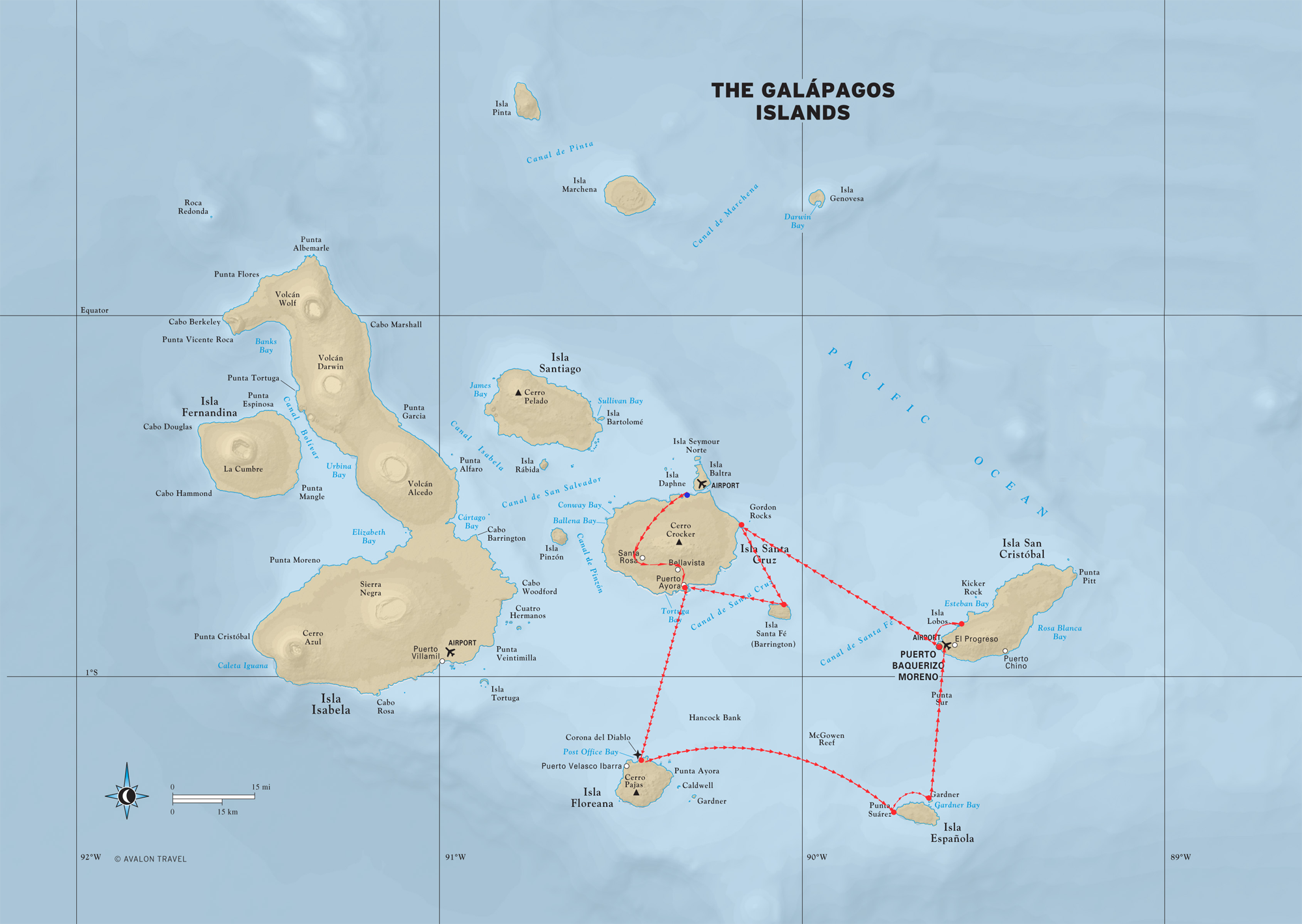 Route shown is for Itinerary E (6 days / 5 nights) = Days 5 - 10
Route shown is for Itinerary E (6 days / 5 nights) = Days 5 - 10
Darwin's Finches, Yellow Warblers, and Bright Red Vermillion Flycatchers will fly in and out of the moss-covered trees. From this high vantage point, if mountain mist doesn't enshroud the forest, you will be treated to beautiful views of the surrounding archipelago.
In the late afternoon you will return to town. For those who wish to check out the nightlife, this is your chance; the boat will be docked in port most of the night.
Day 6: Floreana Island: Cormorant Point (wet landing), Corona del Diablo (wet landing), and Post office bay (wet landing)
When you wake up and look out your porthole on Day 6 you will see Floreana, one of the greenest islands in the archipelago. Ask your guide to tell you about its mysterious history laden with rumours of witches, murderous baronesses, blackmail and dubious disappearances.
Your first stop is Post Office Bay, where the islands' original post office (really only a wooden barrel) was established in 1793. The current system still functions as it did three centuries ago: Visitors drop off unstamped letters and postcards AND pick-up whatever mail they can hand deliver themselves when they return home! (Try it, it actually works!).
Back on the yacht for lunch, you will skirt the island's coast until you arrive at La Corona del Diablo (the Devil's Crown), a sub-marine crater that offers some of the most spectacular snorkeling in the Galapagos. This is a great spot for seeing the wide array of tropical fish, many endemic to the islands, including purple sea stars and spiky sea urchins. The crater's most thrilling undersea creatures, however, are the white-tipped sharks. As with most of the creatures in the Galapagos they are unperturbed by your presence, so you can swim in their company freely and fearlessly.
After returning to the yacht, you will visit Punta Cormorant, where you will follow a footpath to a lagoon inhabited by pink flamingos. You will also pass by Carolina Beach, a Sea Turtle nesting area and a superb spot for watching sea birds and sea rays.
Day 7: Española Island: Suarez Point (dry landing) & Garner Bay (wet landing)
Espanola is one of the most magical of all the islands. It is a place where the animals reign supreme and we humans are merely guests. As your dingy brings you to shore you will see Sea Lion pups sunbathing with Marine Iguanas and Blue Footed Boobies nesting in between, and nearby may be a Galapagos Hawk. If it is Booby mating season watch the bonded pairs do the infamous Booby dance (if it’s not mating season, ask your guide to demonstrate - after all it’s their job to teach you about the local fauna!).
As you follow the footpath around the island, you will pass hundreds of Blue Footed Booby nesting sites including one colony of masked boobies.
There is a good chance that you will see the thief-like Frigate Bird (which has the habit of stealing other birds’ food), as well as the stunning Red-Billed Tropicbird and the nocturnal Swallow-Tailed Gull. If it is the right time of the year (mid-April to December) you’ll also encounter the giant Waved Albatross. Apart from a few pairs that breed on Isla de Plata, off the Ecuadorian mainland, all of the world’s 12,000 Waved Albatross breed on Espanola Island. At the end of the breeding season, the entire population leaves the island and heads out to sea, where they spend years without touching land; four or five years may pass before the fledglings return to Espanola.
As you make your way around the island you will pass by El Soplador, a giant blowhole where waves explodes to heights reaching 25 feet. In the nearby tidal pools you can often find lounging sea lions enjoying the blowhole’s misty spray. Following lunch on board the yacht, you will visit Garner Bay, a great place for sunbathing, swimming and snorkeling. Lionfish, Flycatchers, and Galapagos Hawks will keep you company as you relax under the rays of the evening sun. Dinner on the yacht completes your day.
Day 8: San Cristobal, Isla Lobos / Interpretation Centre / Cerro Tijeretas
On Day 8 you will arrive early in the morning to San Cristobal, the capital of the Galapagos. The first you will site will be Isla Lobos: a small islet made of volcanic rocks which derives its name from the colony of Sea Lions (Lobo de Mar in Spanish) who live there. Here you can observe the behaviour and interaction of Sea Lions living in a small community. Before taking the flight back to the mainland you will have some time to visit the town on your own for last minute shopping or people watching in the Galapagos. Transfer to airport.
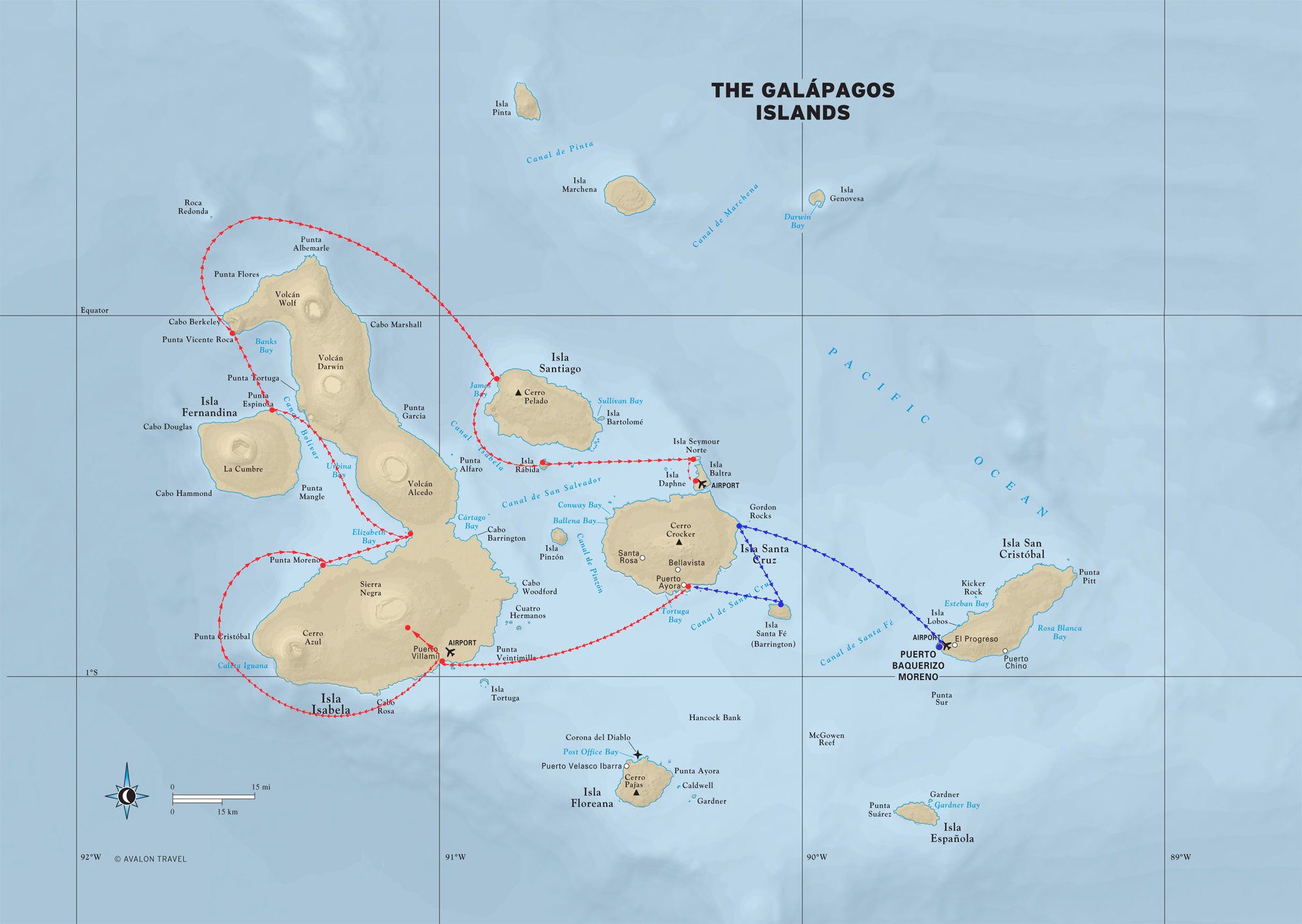
Itinerary B = Blue + Red routes
End of itineraries A & D
Those staying onboard will step onshore to visit the Interpretation Center in Puerto Baquerizo: a local branch of the Galapagos National Park Service, where your guide will explain the formation of the islands, how the flora and fauna arrived and were established in Galapagos; as well as visit the corrals where there are several species of giant tortoises under the care of the National Park Service.
Start of Itinerary B for 8 Days / 7 nights starts San Cristobal & ends Baltra
For those of you arriving today, you will go from the airport straight back to the boat to be show you to your accommodations. Everyone will then visit Cerro Tijeretas located at 2 km from the town of Puerto Baquerizo Moreno. This the only one site where you can see 2 different species of Frigatebirds living in the same colony: the Magnificent Frigatebird and the Great Frigatebird.
Return to the boat to relax and take dinner.
Day 9: Santa Fe / Plazas
After breakfast on the yacht, you'll continue to Santa Fe Island. Upon arrival at the island, you will be treated to a noisy welcome from a local Sea Lion colony. Following your naturalist guide on the island paths you will reach Santa Fe's main attraction: a towering forest of giant Opuntia cacti. Scattered around the Opuntia trees you will see a number of the island's indigenous sun-seekers: marine and land iguanas, rainbow-streaked lava lizards and, if you're lucky, land tortoises - the namesakes of the islands. After the walk you will dive into the salty sea and snorkel in the company of Sea Lions, Lion Fish and Sea Turtles. Finally, you'll return to the yacht for lunch.
After lunch the yacht will navigate to Plazas Islands, anchoring in a channel between North Plaza and South Plaza. North Plaza is off limits to visitors. South Plaza is a very beautiful island, with colourful flora and some splendid Opuntia cactus tree specimens. You will see that more have been planted - protected by screens. Their falling leaves are the food of Land Iguanas, of which there are usually quite a few scattered around the trail. Cactus Finches are something else you may see, as well as a lot of birdlife of the steep cliffs, the opposite side of the island to your landing site. This is a particularly good place to see Red-Billed Tropicbirds; whilst inland Yellow Warblers are usually easy to spot; and by the land-stage, Lava Gulls.
Day 10: Santa Cruz / Darwin Centre / El Chato (Highlands)
End of Itinerary E
Charles Darwin Station. After breakfast you will sail to Santa Cruz Island. Those ending their voyage here will disembark in Puerto Ayora.
Those staying onboard will be taken to visit the Charles Darwin Station and Tortoise Rearing Center; and have time to explore Puerto Ayora town
Start of Itinerary F (6 days / 5 nights)
All guests will take lunch onboard the Aida Maria before exploring the Santa Cruz Highlands. You will learn about the vegetation and animal life of this zone, often strikingly different than that found at lower elevations. You will enjoy your best opportunities here, to find the famous giant tortoises in their natural habitat.
Darwin's Finches, Yellow Warblers, and other land birds will fly in and out of the moss-covered trees. Weather permitting, from this high vantage point you will be treated to beautiful views of the island.
In the late afternoon you will return to Puerto Ayora. For those who wish to check out the nightlife, this is your chance; the boat will be docked in port most of the night.
Return to the boat. Dinner.
Day 11: Isabela Island / Volcan Sierra Negra / Humedales
You will awake off the southern coast of the Galapagos' biggest island: Isabela Your first visit in the morning will take you to Volcan Sierra Negra. You will drive most of the way to the top, after which a walk of around 30 minutes will take you to the crater edge. This is the second largest volcanic crater on our planet (second only to Ngorongoro Crater in Tanzania, which you can also visit with Aqua-Firma); an incredible 6 miles across. Cloud might conceal the view at first, but as you walk east, there is usually an increasing chance of cloud breaking open to revealing more of this shield volcano (altitude 1,124m).
In the afternoon after lunch, you will go to visit the Humedales, which is a mangrove area with small brackish water lagoons that create the perfect environment for a small type of shrimp that serves as the food for the island's flamingos.
Back on board and night navigation to your next site.
Day 12: Punta Moreno / Elizabeth Bay
After night navigation you will arrive at Punta Moreno on the west coast of Isabela - a dry landing site on a lava field. The vegetation found in this area is sparse and concentrated mainly in the mangrove area and around the lakes. It should be noted that the three kinds of cacti are found here.
The main attractions at Punta Moreno are the coastal lagoons, amid black lava flows where there are several species of birds. Here you will have a panoramic view of three of the most active volcanoes in the Galapagos, which are Sierra Negra, Cerro Azul of Isabela Island and La Cumbre of Fernandina Island.
After lunch on board you will continue on your way to Elizabeth Bay, located on Isabela Island`s western shore. This is an excellent spot for observing marine life. You will motor past a few islands where you can usually see Galapagos Penguins; this is one of the best areas to take their photos. A colony of these magnificent birds inhabit a rocky islet at the entrance to Elizabeth Bay.
The Skipper will let our boat drift through a small passage lined with mangroves and eventually emerge into an enclosed cove. The engine will be turned off as you look in these sheltered waters for Marine Turtles, Rays, Flightless Cormorants, Sea Lions, and circling overhead, Galapagos Hawks.
Day 13: Punta Espinoza & Punta Vicente Roca
Punta Espinoza is a narrow ledge of lava and sand that extends from the base of the volcano to the sea. There is a vivid description from Captain Benjamin Morrell who witnessed and recorded and eruption of Fernandina in the 1820's that probably gave rise to the Point. In 1975, there was an uprising, about 90 cm, which is why the pier built for landing can only be used during high tide.
Punta Espinoza is a place famous for its large colonies of Marine Iguanas as well as being the habitat of unique species like the Flightless Cormorant, the Galapagos Penguin, the Galapagos Hawk, and the Galapagos Snake, among others. It's an ideal place to observe the lava cactus (Brachycerus nesioticus), which grows on young lava and survive with little water.
Back on board for lunch and a 2 hours navigation to Punta Vicente Roca.
Punta Vicente Roca lies at the northen tip of Isabela island. It is one of the best places in the Galapagos for snorkeling; a place which is home to sea lions, fur seals, penguins, turtles, flightless cormorants, so there is always the opportunity to find any of this animals in the water. The snorkel takes place along a wall of volcanic ash called a tuff stone, featuring amazing underwater volcanic formations including a small cave where in season it is possible to see sea turtles.
After snorkeling you will step back on board and continue on your way to James island.
Day 14: Puerto Egas / Rabida Island
James Bay is a black sand beach located on the west side of James Bay, in the northwest of Santiago Island. South of the beach is Sugarloaf Volcano, which has deposits of volcanic tuff, the same that helped the formation of the black sand beach. El Cráter is just north of this site. This has a saltwater lagoon, which during the summer dry season becomes a salt mine. Between 1928 and 1930 was the first exploitation of salt; but the efforts did not last long. Then again in 1964 a new attempt was made that lasted for some time.
After lunch on board the yacht will navigate to our next destination: Rabida Island.
Rábida Island consists of a red sand beach, a coastal lagoon behind the beach, and a loop trail. The approximate distance of the trail is 1.1 kilometres.
The colour of the rocks and sand on the beach is due to the very porous volcanic material, which with the help of environmental factors (rain, salt water and sea breeze), has acted as an oxidizing agent.
The main attraction of this spot is the red sand beach and scenery, aside from the vegetation of the arid zone and the presence of native and endemic species.
Day 15: North Seymour Island (dry landing) / Baltra Airport
After an early breakfast you will disembark at North Seymour Island. Here you will see Frigatebirds, Blue-Footed Boobies and ubiquitous Sea Lions. With luck, you might witness the striking courtship display of the male Frigate Bird, in which he inflates a red balloon-like sac below his throat (the gula) and struts his stuff for all of the young females. Seymour North, Plaza Sur, Plaza Norte, Baltra, northeastern Santa Cruz, Santa Fe and part of Española, were all formed by uprisings of underwater volcanic lava. They were part of a volcanic lava table deposited in sheet form along cracks located on the ocean floor. The uprisings occurred sporadically and lasted more than a million years to reach its current level.
All marine fossils found in the archipelago are found in these islands and the best example is the North Channel side of Baltra. The fossils date from the Pleistocene, and specifically in the case of Baltra, one can say that these volcanic tables were close to the surface about a million years ago.
Return to the boat & sail to Baltra Island to catch your plane back to the mainland.
Dates
Contact us for details about any further discounts which may apply.
Child Discount 20% discount applies for children under 10 years at all points during the yacht safari (no more than 2 child discounts available per cruise)
Our prices include
Galapagos safari as indicated
Shore excursions and zodiac activities
All meals onboard vessels
Coffee, tea and water
All boats are accompanied by English speaking naturalist guides who have been trained by the Charles Darwin Station and are licensed by the National Park.
A year's membership to the Galapagos Conservation Trust.
(*subject to availability)
Our prices exclude
Flights
Airport transfer bus on Baltra US$5**
Galapagos National Park entrance fee & immigration tax - $110** per person to be paid in cash at the airport in Galápagos).
Drinks, tips, snorkel equipment (US$5 / day**) and wet suit rental (US$10 / day**).
Travel insurance.
INGALA Immigration fee payable at Quito & Guayaquil airports (US$10**)
(**correct at time of writing)
Isabela landing tax for Itinerary B
Single Supplements
If you are willing to share your cabin with another person of the same gender then there is no single supplement. For single cabin occupancy add 80% to the per person cabin price.

